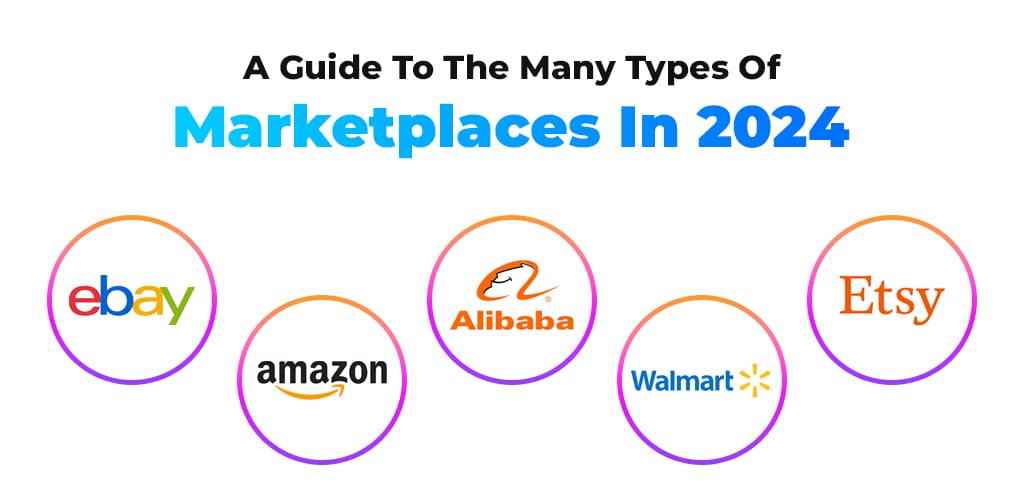A Guide To The Many Types Of Marketplaces In 2024
The modern commerce industry has made marketplaces—also referred to as e-marketplaces or online/digital marketplaces—a vital component. These marketplaces offer a vast range of goods and services while facilitating interactions between buyers and sellers.
Online markets will have evolved into a number of different forms by 2024 in order to satisfy the needs of various users and business objectives.
This article will give an overview of online shopping platforms, look at the different kinds, compare them, and see how they can work together and connect with each other.

Overview of Marketplaces
Marketplaces are online venues that link vendors and buyers to conduct business virtually.
These platforms can range from broad online stores with a wide variety of products, like Amazon and eBay, to bespoke stores focused on specific types of items.
A marketplace’s main purpose is to give buyers and sellers a location to browse, compare, and buy goods and services that sellers have listed.
Typically, marketplaces make money via a variety of strategies, including advertising, listing fees, commission fees, and subscription costs.
A marketplace’s ability to draw in customers and sellers and foster a thriving ecology where transactions can occur is what affirms its success.
Types of Marketplaces

B2C Marketplaces
Marketplaces known as “business-to-consumer” (B2C) are online stores where companies sell goods or services to customers directly. These markets, which comprise behemoths like Amazon, Alibaba, and Walmart, are the most prevalent kind.
B2C marketplaces provide a broad selection of commodities, ranging from groceries and digital goods to apparel and gadgets.
Key Characteristics:
- Direct communication between companies and customers.
- Broad selection of goods and services;
- Listing fees, commissions, and advertising are among the revenue streams.
Examples:
- Amazon: Offers a vast array of products from various sellers.
- Alibaba: Connects Chinese manufacturers with consumers globally.
- Walmart: Provides a mix of its own products and third-party sellers.
B2B Marketplaces
Marketplaces that facilitate business-to-business (B2B) transactions serve companies seeking to purchase or sell goods or services to other companies.
These markets are crucial for industrial procurement, wholesale deals, and supply chain management.
Key Characteristics:
- Deals involving different companies.
- Frequently involves specialised goods or services;
- Puts an emphasis on long-term contracts and large purchases.
Examples:
- Alibaba.com: A section of Alibaba focused on wholesale transactions.
- ThomasNet: connects industrial buyers with suppliers.
- Handshake: A wholesale marketplace for retailers and brands.
C2C Marketplaces
Marketplaces that allow consumers to deal with each other (C2C) make transactions easier.
These marketplaces are well-liked for the sale of handcrafted goods, secondhand goods, and personal services. They mostly rely on peer-to-peer interactions and user-generated content.
Key Characteristics:
- Deals made by individual customers.
- Frequently includes user reviews and ratings;
- Places a strong emphasis on handmade goods, services, and used goods.
Examples:
- eBay: An auction-style marketplace for various goods.
- Etsy: focuses on handmade and vintage items.
- Poshmark: specializes in second-hand fashion.

Horizontal vs. Vertical Marketplaces
Another way to classify marketplaces is by the range of products they offer.
Horizontal Marketplaces
Another way to classify marketplaces is by the range of products they offer.
A large variety of products in several categories are available on horizontal marketplaces. With these platforms, customers should be able to locate almost anything they need in one place.
The primary benefit of horizontal markets is their capacity to draw in a wide range of clients.
Key Characteristics:
- Broad target audience;
- Extensive range of goods and services;
- Frequently equipped with powerful search and discovery features.
Examples:
- Amazon: Sells everything from books to electronics to groceries.
- eBay: Offers products across numerous categories, from fashion to collectibles.
- Rakuten: Provides a diverse range of goods and services.
Vertical Marketplaces
Vertical marketplaces focus on a particular market or sector. These platforms provide specialised goods and services to a certain market sector.
Vertical marketplaces provide specialised experiences and in-depth expertise because they frequently have a greater understanding of their niche.
Key Characteristics:
- Focus on a specific industry or category.
- Specialized products and services.
- Often include expert advice and detailed product information.
Examples:
- Reverb: A marketplace for musical instruments and gear.
- Farfetch: Focuses on luxury fashion.
- Houzz: Specializes in home improvement and design.

Mixing Marketplace Integrations: Marketplace In and Marketplace Out
Marketplaces can integrate with each other to expand their reach and improve their offerings. These integrations can be categorized into “Marketplace In” and “Marketplace Out.”
Marketplace In Integration
Marketplace In integration involves a marketplace incorporating products or services from other marketplaces into its own platform.
This allows the marketplace to offer a broader range of products without having to source them directly.
For example, a fashion marketplace might integrate products from various boutique marketplaces, offering consumers a wider selection of items.
Benefits:
- Expanded product range.
- Enhanced customer experience.
- Increased revenue potential.
Challenges:
- Managing relationships with multiple marketplaces.
- Ensuring consistent product quality and customer service.
Marketplace Out Integration
Marketplace Out integration involves a marketplace making its products or services available on other marketplaces.
This strategy helps sellers reach a larger audience and increase sales. For instance, a B2B supplier might list its products on several B2B marketplaces to maximize exposure.
Benefits:
- Increased visibility and sales opportunities.
- Access to new customer bases.
- Enhanced brand recognition.
Challenges:
- Coordinating listings and inventory across multiple platforms.
- Maintaining pricing consistency and brand integrity.

Differences and Similarities between Marketplaces
While B2C, B2B, and C2C marketplaces serve different audiences and purposes, they share some common characteristics.
All online shopping platforms aim to make transactions easy, give sellers a place to reach buyers, and make money through different methods.
Differences
- Target Audience: B2C platforms cater to regular shoppers, B2B platforms serve businesses, and C2C platforms connect individual sellers with buyers.
- Transaction Size and Frequency: B2B transactions often involve larger volumes and long-term contracts, while B2C and C2C transactions tend to be smaller and more frequent.
- Product Types: B2C and C2C platforms often feature everyday products for consumers, while B2B platforms focus on industrial goods, raw materials, and bulk items.
Similarities
- Platform Features: All marketplaces provide search and discovery tools, payment processing, and customer support.
- Revenue Models: Common revenue models include commission fees, listing fees, and advertising.
- User Trust and Safety: Making sure transactions are safe and building trust between buyers and sellers is important for all types of online shopping platforms.

The Future of Marketplaces
As we move further into 2024, online shopping platforms will keep evolving and adjusting to changing consumer habits and new technologies.
Key trends shaping the future of marketplaces include:
AI and Machine Learning
Artificial intelligence (AI) and machine learning will play a significant role in enhancing marketplace experiences.
These technologies can improve product recommendations, optimize search results, and provide personalized shopping experiences.
For example, AI-driven chatbots can assist customers in finding products, answering questions, and resolving issues.
Augmented Reality (AR) and Virtual Reality (VR)
AR and VR technologies will transform how consumers interact with products online. Marketplaces can leverage these technologies to offer virtual try-ons, immersive product demonstrations, and virtual store tours.
This will enhance the online shopping experience, making it more interactive and engaging.
Blockchain Technology
Blockchain technology can improve transparency, security, and trust in marketplaces.
By providing a decentralized and immutable ledger, blockchain can ensure the authenticity of products, secure transactions, and reduce fraud.
For instance, luxury goods marketplaces can use blockchain to verify the provenance of high-value items.
Sustainability and Ethical Commerce
Consumers are increasingly conscious of sustainability and ethical practices.
Marketplaces that prioritize eco-friendly products, fair trade, and ethical sourcing will gain a competitive edge. This trend will drive the growth of marketplaces focused on sustainable and socially responsible products.
Omnichannel Integration
The integration of online and offline channels will become more seamless, offering consumers a cohesive shopping experience.
Marketplaces will leverage data from various touchpoints to provide personalized and consistent experiences across all channels.
For example, a customer might browse products online, check availability in a local store, and make a purchase through a mobile app.

Why Avasam Enterprise?
Harness the power of the Avasam Enterprise Platform to scale your business faster with your own custom network of third-party suppliers and dropshipping solutions.
With Avasam Enterprise, you can increase your product range without tying up capital, allowing you to offer a diverse choice of items without the burden of inventory costs. The platform ensures that the right products are provided to the right customers, enhancing your ability to meet customer demands and preferences effectively.
Recognized as an award-winning software, Avasam Enterprise is a tried and tested solution that has proven its reliability and efficiency in the market. Additionally, you receive robust support whenever you need it, ensuring seamless operations and continuous growth for your business.
Conclusion
Online shopping platforms are a vital part of the commerce industry, constantly changing to meet the needs of buyers and sellers.
Whether it’s B2C, B2B, or C2C, each type of marketplace offers unique advantages and caters to specific audiences. The distinction between horizontal and vertical marketplaces further diversifies the marketplace landscape.
As online shopping platforms connect with each other through “Marketplace In” and “Marketplace Out” strategies, they expand their reach and improve their offerings.
The future of online shopping platforms will be shaped by new technologies, shifting consumer preferences, and a greater focus on sustainability and ethical practices.
In 2024 and beyond, marketplaces will continue to innovate, providing more efficient, secure, and engaging platforms for commerce.
By learning about the different types of online shopping platforms and what makes each one unique, businesses and consumers can better navigate this vibrant space and make the most of it.







DropShip products from verified suppliers to diversify your inventory and scale your eCommerce business